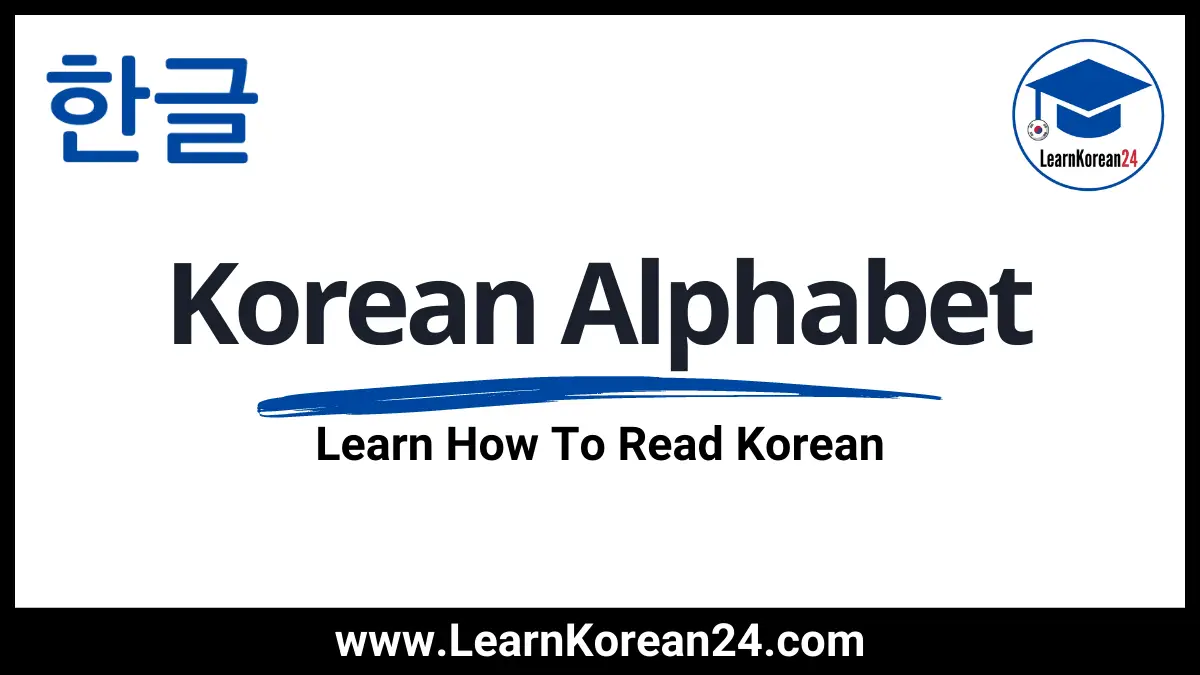The Korean Alphabet | Learn How To Read Hangul (한글)
If you want to learn Korean, you must first learn how to read the Korean alphabet. Luckily, Hangul is relatively easy to learn, and many can learn to read Korean characters in as little as 24 hours. In the lesson below, you’ll learn how to read and pronounce all the Korean letters of the alphabet and how to read Korean words. Already learned how to read Korean? Then get started with our free online Korean language course.
Related: Free Korean Alphabet Worksheets / Free Korean Alphabet Flashcards
Korean Alphabet: Basic Consonants
First, let’s learn how to read Korean basic consonants. There are 14 basic consonants in the Korean alphabet. These are ㄱ, ㄴ, ㄷ, ㄹ, ㅁ, ㅂ, ㅅ,ㅇ, ㅈ, ㅊ, ㅋ, ㅌ, ㅍ,ㅎ. Let’s learn the sounds of each of these Korean consonants one by one. Look at the pictures and try to remember the consonant sounds. Then click on the audio to hear a native Korean speaker pronounce these Korean consonants.
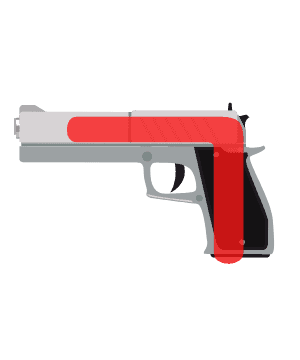
ㄱ
The Korean character ㄱ sounds like the ‘g’ in gun.
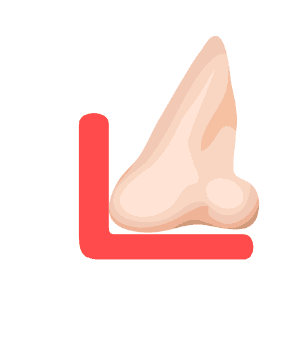
ㄴ
The Korean character ㄴ sounds like the ‘n’ in nose.
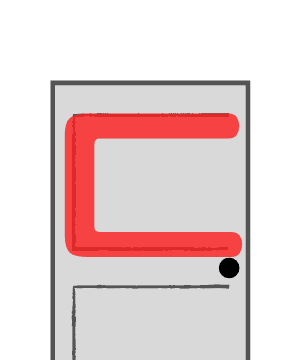
ㄷ
The Korean character ㄷ sounds like the ‘d’ in door.
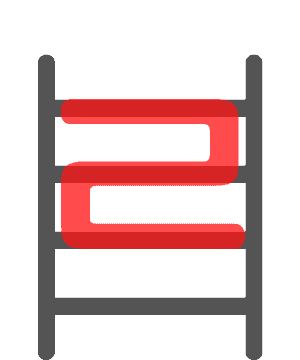
ㄹ
The Korean character ㄹ sounds similar to the ‘l’ in ladder.
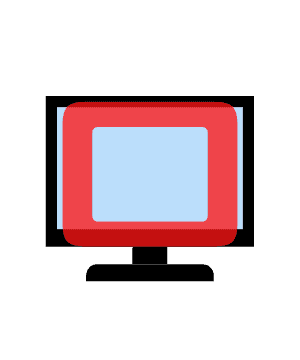
ㅁ
The Korean character ㅁ sounds like the ‘m’ in monitor.
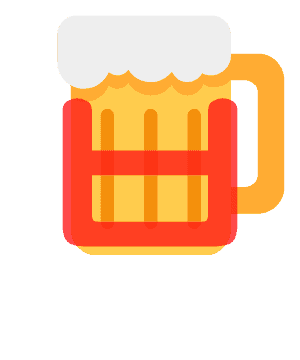
ㅂ
The Korean character ㅂ sounds like the ‘b’ in beer.
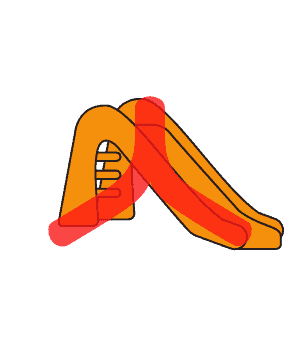
ㅅ
The Korean character ㅅ sounds like the ‘s’ in slide.

ㅈ
The Korean character ㅈ sounds like the ‘j’ in jellyfish.

ㅊ
The Korean character ㅊ sounds like the ‘ch’ in church.
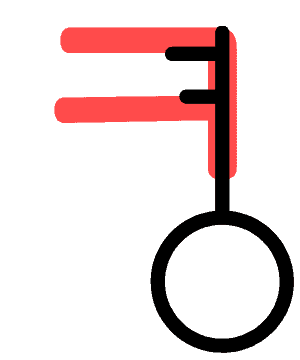
ㅋ
The Korean character ㅋ sounds like the ‘k’ in key.

ㅌ
The Korean character ㅌ sounds like the ‘t’ in teeth.
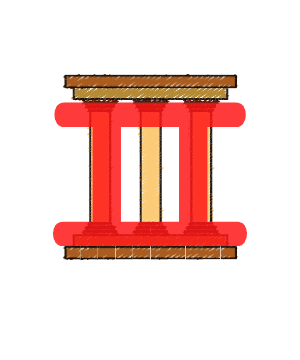
ㅍ
The Korean character ㅍ sounds like the ‘p’ in pillar.

ㅎ
The Korean character ㅎ sounds like the ‘h’ in hat.
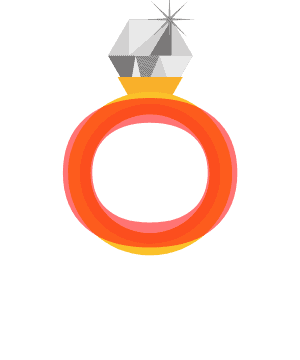
ㅇ
The Korean character ㅇ sounds like the ‘ng’ in ring.
*ㅇ only makes a sound when it is at the end of the syllable. At the start, it is silent.
Korean Alphabet: Basic Vowels
Next, you will learn how to read Korean basic vowels. There are 10 basic vowels in the Korean alphabet which areㅏ, ㅑ, ㅓ, ㅕ, ㅗ, ㅛ, ㅜ, ㅠ, ㅡ, ㅣ. Look at the Korean vowels below and read the instructions on how to pronounce them. Then, click on the audio to the sound these Korean characters make.
ㅏ
ㅏ = a
The Korean vowel ㅏ sounds like the short ‘a‘ vowel sound in English. ㅏ sounds like the ‘a‘ in apple.
ㅑ
ㅑ= ya
The Korean vowel ㅑ makes the sound ‘ya’. Notice how it is similar to the previous vowel but with an extra line? The extra line changes the ‘a’ sound into ‘ya’.
ㅓ
ㅓ = eo
The Korean vowel ㅓ sounds like the short o vowel sound in English. It sounds like the ‘o’ in the words pod, mop, job, etc.
ㅕ
ㅕ= yeo
The Korean vowel ㅕ makes the sound ‘yeo’. Again, it is similar to the previous vowel but with an extra line, right? The extra line changes the ‘eo’ sound into ‘yeo’.
ㅗ
ㅗ = o
The Korean vowel ㅗ sounds like the long o vowel sound in English. It sounds like the ‘o’ in the words bone, stone, coat, etc.
ㅛ
ㅛ = yo
The Korean vowel ㅛ makes the sound ‘yo’. Again, the extra line changes the ‘o’ sound into ‘yo’. ㅛ sounds like the ‘yo‘ in the word ‘yo-yo’.
ㅜ
ㅜ = u
The Korean vowel ㅜ sounds like the long u vowel sound in English. It sounds like the ‘u’ sound in the words mule, tune, blue, etc.
ㅠ
ㅠ = yu
The Korean vowel ㅠ makes the sound ‘yu’. The extra line changes the ‘u’ sound into ‘yu’. ㅠ sounds like the word ‘you’ in English.
ㅡ
ㅡ = eu
The Korean vowel ㅡ sounds similar to the short u vowel sound in the English words umbrella, put, mud, etc. However, it is slightly different and requires a unique mouth position.
ㅣ
ㅣ= i
The Korean vowel ㅣsounds like the long e sound in English.
ㅣ sounds like the ‘ee’ in the words meet, feet, tree, etc.
Korean Alphabet: Combined Vowels
Next, let’s take a look at how to read Korean combined vowels. These are made up by combining two simple vowels. The combined vowels you will learn are: ㅐ, ㅒ, ㅔ, ㅖ, ㅘ, ㅙ, ㅚ, ㅝ, ㅞ, ㅟ, ㅢ. Read the instructions below, and try to pronounce these vowels. Then, click on the audio to listen to a native Korean speaker say these Korean characters.
ㅐ
ㅐ = ae
This combined vowel is ㅏ + ㅣ. Together they make ㅐ which sounds like the ‘e‘ in egg and elephant.
ㅒ
ㅒ = yae
This combined vowel is ㅑ + ㅣ. Together they make ㅒ which sounds like the ‘ye‘ in yes and yesterday.
ㅔ
ㅔ = e
This combined vowel is ㅓ + ㅣ. Together they make ㅔ which again sounds like the ‘e‘ in egg and elephant.
*ㅐ and ㅔ are different sounds in theory, but people pronounce them the same and even native Korean speakers often cannot differentiate between the two.
ㅖ
ㅖ = ye
This combined vowel is ㅕ + ㅣ. Together they make ㅖ which again sounds like the ‘ye‘ in yes and yesterday.
Again, ㅒ and ㅖ are technically different sounds but in reality, they are pronounced the same.
ㅘ
ㅘ = wa
This combined vowel is ㅗ + ㅏ. Together they make ㅘ which makes the sound ‘wa‘.
To make this sound, begin by shaping your mouth to make the ㅗ sound. Then start to say the ㅗ sound and then quickly say the ㅏ sound. The resulting sound is ㅘ (wa).
ㅙ
ㅙ = wae
This compound vowel is ㅗ + ㅐ. Together they make ㅙ.
To make this sound begin by shaping your mouth to make the ㅗ sound. Then start to say the ㅗ sound and then quickly say the ㅐ sound.
The resulting sound is ㅙ (wae) as in ‘wedding’.
*ㅙ , ㅚ, ㅞ all sound the same.
ㅝ
ㅝ= weo
This compound vowel is ㅜ + ㅓ. Together they make ㅝ.
To make this sound begin by shaping your mouth to make the ㅜ sound. Start to say the ㅜ sound and then quickly say the ㅓ sound. The resulting sound is ㅝ which is similar to the ‘wa‘ in walk.
ㅞ
ㅞ= we
This combined vowel is ㅜ + ㅔ. Together they make ㅞ.
To make this sound begin by shaping your mouth to make the ㅜ sound. Then start to say the ㅜ sound and then quickly say the ㅔ sound. The resulting sound is ㅞ (we). Again this sounds like the ‘we‘ in wedding.
*ㅙ , ㅚ, ㅞ all sound the same.
ㅚ
ㅚ= oe
This combined vowel is ㅗ + ㅣ. Together they make ㅚ.
To make this sound begin by shaping your mouth to make the ㅗ sound. Then start to say the ㅗ sound and then quickly say the ㅣ sound. The resulting sound is ㅚ (oe) which also sounds like the ‘we‘ in ‘wedding’.
*ㅙ , ㅚ, ㅞ all sound the same.
ㅟ
ㅟ= wi
This compound vowel is ㅜ + ㅣ. Together they make ㅟ.
To make this sound begin by shaping your mouth to make the ㅜ sound. Then start to say the ㅜ sound and then quickly say the ㅣ sound. The resulting sound is ㅟ (wi) which sounds like the ‘wee‘ in the word week.
ㅢ
ㅢ = ui
This last compound vowel is ㅡ + ㅣ. Together they make ㅢ.
To make this sound begin by shaping your mouth to make the ㅡ sound. Start to say the ㅡ sound and then quickly say the ㅣ sound. The resulting sound is ㅢ. *
How To Read Korean Words
Now that you have learned the basic Korean letters, it’s time to learn how to read Korean words. Korean, just like English, is read left to right and top to bottom. Korean words are made up of ‘syllable blocks’ and each syllable block has a minimum of 2 letters and a maximum of 4 letters. See the below examples.
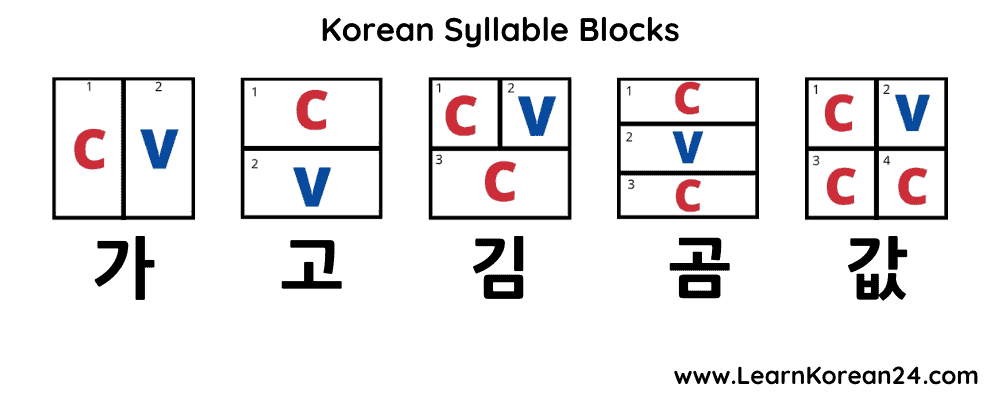
In Korean, syllables must always start with a consonant. For this reason, Korean words that start with a vowel sound must include a silent consonant before the vowel. This silent consonant is ㅇ. As we learned earlier, ㅇ sounds like the ‘ng‘ in the word ring. However, when ㅇ is the first letter in a syllable block it is always silent. See the picture below.
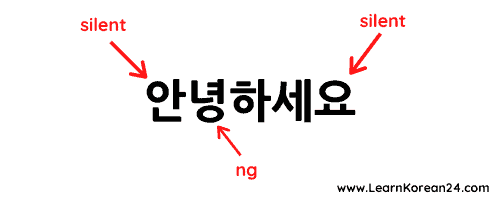
In the above picture, the first syllable block is 안 (an). You’ll notice that the first Korean letter is ㅇ. In this position, it is always silent. Because all syllables must start with a consonant, when writing words that start with a vowel sound, we must start the syllable with the silent consonant ㅇ. The second syllable block in the picture above is 녕 (nyeong). As you can see ㅇ is the final consonant in that syllable block. In this position, ㅇ is pronounced as ‘ng‘.
Let’s try to read some simple Korean words. Look at the words below and try to read them out loud. If you’re not sure what a particular letter should sound like, scroll up the page to review that letter’s sound. After reading each word, play the audio to check if you were right.
이
이 = tooth
아이
아이 = kid
오이
오이 = cucumber
우유
우유 = milk
고기
고기 = meat
구두
구두 = dress shoes
나라
나라 = country
바나나
바나나 = banana
Korean Alphabet: Double Consonants
Next, let’s learn how to read Korean double consonants. Korean double consonants are a little difficult to pronounce if you are new to studying the Korean alphabet. But with a little practice, you will be saying Korean double consonants in no time. The Korean double consonants we will learn are: ㅃ, ㅉ, ㄸ, ㄲ, ㅆ
If they look familiar it’s because these double consonants are just a single Korean consonant twice. Double consonants are pronounced the same as single consonants but are stressed with more emphasis. Watch the video below to listen to the difference between single and double consonant sounds in Korean.
Batchim Sounds (Final Consonant)
So far you have learned how to read Korean basic consonants, basic vowels, combined vowels, and double consonants. The last thing you need to learn is about Korean final consonants known as ‘Batchim‘ (받침). When consonants are in the final syllable position, they make a different sound. Keep reading to learn the Korean Batchim rules.
Final Consonants ㅌ, ㄷ , ㅅ,ㅎ, ㅆ, ㅈ, ㅊ
These 7 consonants are all pronounced the same when in the final consonant (받침) position. So, to learn how to pronounce these consonants as a batchim, we just need to learn one. Let’s look at how to pronounce ㅌ as a final consonant. As we learned earlier ㅌ sounds like the ‘t‘ in ‘teeth’. However, when ㅌ is in the final position in the syllable it is pronounced slightly differently.
To help you understand how to pronounce ㅌ as a batchim, first I want you to place your hand in front of your mouth and say the word ‘bat‘ as you normally would in English. When you pronounce the ‘t‘ sound you will notice there is a small expulsion of air. Now, say ‘bat‘ again but this time stop yourself from making this expulsion of air when you say the ‘t‘ sound. This second way of saying ‘t‘ without the expulsion of air is how you pronounce ㅌ when it is in the final syllable consonant position.
The consonants ㅌ, ㄷ, ㅅ, ㅎ, ㅆ, ㅈ, and ㅊ all make this sound when in the final consonant (받침) position. Listen to the example words below to hear how these letters sound as a batchim (받침).
ㅌ
Example Word: 밑
ㄷ
Example Word: 걷
ㅅ
Example Word: 옷
ㅎ
Example Word: 낳
ㅆ
Example Word: 있
ㅈ
Example Word: 낮
ㅊ
Example Word: 꽃
Final Consonants ㄱ, ㅋ, and ㄲ
Next let’s look at the final consonants ㄱ, ㅋ, and ㄲ. As we learned earlier, ㄱ sounds like the ‘g‘ in gun, ㅋ sounds like the ‘k‘ in key, and ㄲ sounds like ㄱ but with more stress/emphasis. However, as a final syllable consonant, ㄱ, ㅋ and ㄲ all sound the same.
To understand how these are pronounced, again place your hand in front of your mouth and say the word ‘dog‘ as you would normally in English. When you say the ‘g‘ sound you’ll notice a puff of air is expelled. Now say ‘dog‘ again but this time do not let any air out when you say ‘g‘. This is the sound of ㄱ, ㅋ, and ㄲ when they are in the batchim position. Listen to the example words below to hear how these letters sound as a batchim (받침).
ㄱ
Example Word: 죽
ㅋ
Example Word: 부엌
ㄲ
Example Word: 밖
Final Consonants ㅂ and ㅍ
As a batchim, both ㅂ and ㅍ make a ‘b‘ sound. Again, there is no expulsion of air when you say these sounds. Listen to the examples below.
ㅂ
Example Word: 입
ㅍ
Example Word: 앞
Final Consonants ㄴ, ㄹ, ㅁ, and ㅇ
The last final consonants to learn are the easiest to learn because they don’t change their sound when they are in the final consonant position. These are ㄴ, ㄹ, ㅁ, and ㅇ. Listen to the example words below to hear how these letters sound as a batchim (받침).
ㄴ
Example Word: 눈
ㄹ
Example Word: 발
ㅁ
Example Word: 봄
ㅇ
Example Word: 강
CONGRATULATIONS!!!
You have now learned everything you need to know to read Korean and start Korean Korean words and sentences. Don’t worry if you cannot read Korean words very fast just yet. As you learn more and more Korean, reading in Korean will become second nature. Now that you can read Korean, practice writing the Korean alphabet with our free Korean alphabet worksheets, or start our free online Korean course.
STUDY ONLINE WITH KOREAN ARAH!
Ready to take your Korean to the next level?
Get One-on-One Korean lessons from a qualified and experienced Korean language tutor!

